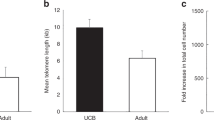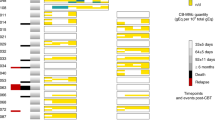Abstract
The number of infused cells is a very important factor in cord blood transplant (CBT) engraftment. Prior ex vivo expansion of aliquots of transplanted cord blood (CB) units is being investigated as a procedure to increase engraftment potential, but results are difficult to evaluate due to a lack of markers for assessing the contribution of expanded cells. We transplanted five patients, infusing the best available CB unit and cells from a second donor simultaneously. In two patients, these cells were obtained from another frozen CB unit by CD34+positive selection and culture expansion; the other three patients received uncultured highly purified haploidentical CD34+ cells. The first two patients had DNA from the culture expanded CB cells detected only for a few days around day +11 when the absolute neutrophil count (ANC) was >200/μl; thereafter and when the ANC was <500/μl, only donor DNA from the uncultured CB was detected. For the other three patients, DNA analysis showed early and transient granulocyte engraftment of haploidentical cells, progressively replaced by the CB-derived granulocytes. We concluded that: (1) simultaneous infusion of lymphocyte-depleted HLA highly mismatched haematopoietic progenitor cells has not produced unfavourable effects for CBT; (2) the double transplant model is suitable for evaluating the engraftment potential of ex vivocultured CB cells in the clinical setting; (3) the culture conditions used did not result in early recovery of ANC; and (4) co-transplantation of purified uncultured HLA haploidentical CD34+ cells may reduce the time of neutropenia following CBT.Bone Marrow Transplantation (2001) 28, 355–363.
This is a preview of subscription content, access via your institution
Access options
Subscribe to this journal
Receive 12 print issues and online access
$259.00 per year
only $21.58 per issue
Buy this article
- Purchase on Springer Link
- Instant access to full article PDF
Prices may be subject to local taxes which are calculated during checkout







Similar content being viewed by others
References
Wagner JE, Kernan NA, Steinbuch R et al. Allogeneic sibling umbilical-cord-blood transplantation in children with malignant and non-malignant disease Lancet 1995 346: 214–219
Wagner JE, Rosenthal J, Sweetman R et al. Successful transplantation of HLA-matched and HLA-mismatched umbilical cord blood from unrelated donors: analysis of engraftment and acute graft-versus-host disease Blood 1996 88: 795–802
Kurtzberg J, Laughlin M, Graham ML et al. Placental blood as a source of hematopoietic stem cells for transplantation into unrelated recipients New Engl J Med 1996 335: 157–166
Gluckman E, Rocha V, Boyer-Chammard A et al. Outcome of cord-blood transplantation from related and unrelated donors New Engl J Med 1997 337: 373–381
Rubinstein P, Carrier C, Scaradavou A et al. Outcome among 562 recipients of placental blood transplants from unrelated donors New Engl J Med 1998 339: 1565–1577
Rocha V, Wagner JE, Sobocinski KA et al. for Eurocord Graft-versus-host disease in children who have received a cord blood or bone marrow transplant from an HLA–identical sibling New Engl J Med 2000 342: 1846–1854
Rocha V, Cornish J, Sievers E et al . for Eurocord Comparison of the outcome of unrelated bone marrow or cord blood transplant in children with acute leukemia Blood 1999 94: (Suppl. 1) (Abstr. 3143)
Wagner JE, DeFor T, Barker J et al. Superior survival in recipients of umbilical cord blood (UCB): results of a case controlled analysis comparing UCB and bone marrow from unrelated donors Blood 1999 94: (Suppl. 1) (Abstr. 3142)
Long G, Madan J, Kurtzberg J et al. Unrelated umbilical cord blood transplants in adult patients with hematologic malignancies or genetic disorders Blood 1999 94: (Suppl. 1) (Abstr. 2544)
Barker NJ, DeFor T, Verfaille CM et al. Transplantation of mismatched unrelated donor umbilical cord blood in adult patients with high risk disease: outcome in recipients of 1–2 107 nucleated cells/kilogram Blood 1999 94: (Suppl. 1) (Abstr. 2562)
Thomson BG, Robertson KA, Gowan D et al. Analysis of engraftment, graft-versus-host disease, and immune recovery following unrelated donor cord blood transplantation Blood 2000 96: 2703–2711
Rocha V, Arcese W, Sanz G et al . for Eurocord Prognostic factors of outcome after unrelated cord blood transplant in adults with hematologic malignancies Blood 2000 96: 587a (Abstr. 2521)
Fernandez MN, Millan I, Gluckman E . Cord blood transplants (letter) New Engl J Med 1999 340: 1287
Migliaccio, AR, Adamason JW, Stevens CE et al. Cell dose and speed of engraftment in placental/umbilical cord blood transplantation: graft progenitor cell content is a better predictor than nucleated cell quantity Blood 2000 96: 2717–2722
Kögler G, Nürberger W, Fisher J et al. Simultaneous cord blood transplantation of ex vivo cells expanded together with non-expanded cells for high risk leukaemia Bone Marrow Transplant 1999 24: 397–403
Schpall EJ, Quinones R, Jones R et al. Transplantation of adult and paediatric cancer patients with cord blood progenitors expanded ex vivo Blood 1999 94: (Suppl. 1) (Abstr. 3145)
Kurtzberg J, Martin PL, Driscol T et al. Augmentation of umbilical cord blood transplantation with ex vivo expanded cells, a phase I trial using the replicell system Blood 1999 94: (Suppl. 1) (Abstr. 2545)
Pecora AL, Stiff P, Jennis A et al. Prompt and durable engraftment in two older adult patients with high risk chronic myelogenous leukemia (CML) using ex vivo expanded and unmanipulated unrelated umbilical cord blood Bone Marrow Transplant 2000 25: 797–799
Fernandez MN, Grañena A, Millán I et al. Evaluation of engraftment of ex vivo expanded cord blood cells in humans Bone Marrow Transplant 2000 25: (Suppl. 2) S61–S67
Güenechea G, Segovia JC, Albella B et al. Delayed engraftment of non obese diabetic/severe combined immunodeficient mice transplanted with ex vivo-expanded human CD34+ cord blood cells Blood 1999 93: 1097–1105
Rosler ES, Brandt JE, Chute J et al. Competitive engraftment potential of primary ex vivo expanded cord blood CD34+ cells in a triple HLA-mismatched SCID-hu bone model Blood 1999 94: (Suppl. 1) (Abstr. 3120)
Piacibello W, Sanavio F, Severino A et al. Engraftment in non-obese diabetic severe combined immunodeficient mice of human CD34+ cord blood cells after ex-vivo expansion: evidence for the amplification and self-renewal of repopulating stem cells Blood 1999 93: 3736–3749
Weinreb S, Yunis EJ, Cohn G et al. Transplantation of unrelated cord blood cells Bone Marrow Transplant 1998 22: 193–196
Rachamin N, Gan J, Segall H et al. Tolerance induction by ‘megadose’ hematopoietic transplants: donor type human CD34 stem cells induce potent specific reduction of host anti-donor cytotoxic T lymphocyte precursors in mixed lymphocyte culture Transplantation 1998 65: 1386–1393
Querol S, Capmany G, Azqueta C et al. Direct immunomagnetic method for CD34+ cell selection from cryopreserved cord blood grafts for ex-vivo expansion protocol Transfusion 2000 40: 625–631
Arguello JR, Little AM, Pay AL et al. Mutation detection and typing of polymorphic loci through double-strand conformation analysis Nat Genet 1998 18: 192–194
Broxmeyer HE, Hangoc G, Cooper S et al. Growth characteristics and expansion of human umbilical cord blood and estimation of its potential for transplantation in adults Proc Natl Acad Sci USA 1992 89: 4109–4113
Payne TA, Traycoff CM, Laver J et al. Phenotypic analysis of early hematopoietic progenitors in cord blood and determination of their correlation with clonogenic progenitors: relevance to cord blood stem cell transplantation Bone Marrow Transplant 1995 15: 187–192
de Wynter EA, Nadali G, Coutinho LH, Testa NG . Extensive amplification of single cells from CD34+ subpopulations in umbilical cord blood and identifications of long term culture initiating cells present in two subsets Stem Cells 1996 4: 566–576
Wang JCY, Doedens M, Dick JE . Primitive human hematopoietic cells are enriched in cord blood compared with adult bone marrow or mobilized peripheral blood as measured by the quantitative in vivo SCID-repopulating cell assay Blood 1997 89: 3919–3924
Noort WA, Rad M, van der Marel A et al. Qualitative differences in CD34+ cells of umbilical cord blood, bone marrow and mobilized blood are responsible for differential engraftment in NOD/SCID mice Blood 1999 94: (Suppl. 1) (Abstr. 2546)
Aversa F, Tabilio A, Velario A et al. Treatment of high-risk leukemia with T-cell depleted stem cells from related donors with one fully mismatched HLA haplotype New Engl J Med 1998 339: 1186–1193
Guinan EC, Boussiotis VA, Neuberg D et al. Transplantation of anergic histoincompatible bone marrow allografts New Engl J Med 1999 340: 1704–1714
Acknowledgements
We wish to thank the ‘Fundación Ramón Areces’ and the ‘Fundación Josep Carreras’ for financial support of this work. Mrs P Dodi is acknowledged for her skilled editorial help.
Author information
Authors and Affiliations
Rights and permissions
About this article
Cite this article
Fernández, M., Regidor, C., Cabrera, R. et al. Cord blood transplants: early recovery of neutrophils from co-transplanted sibling haploidentical progenitor cells and lack of engraftment of cultured cord blood cells, as ascertained by analysis of DNA polymorphisms. Bone Marrow Transplant 28, 355–363 (2001). https://doi.org/10.1038/sj.bmt.1703143
Received:
Accepted:
Published:
Issue Date:
DOI: https://doi.org/10.1038/sj.bmt.1703143
Keywords
This article is cited by
-
Combination of a haploidentical SCT with an unrelated cord blood unit: a single-arm prospective study
Bone Marrow Transplantation (2014)
-
Quantitative monitoring of multi-donor chimerism: a systematic, validated framework for routine analysis
Bone Marrow Transplantation (2010)
-
Ex vivo expansion of cord blood
Bone Marrow Transplantation (2009)
-
Future of cord blood for oncology uses
Bone Marrow Transplantation (2009)
-
Cord blood transplants supported by co-infusion of mobilized hematopoietic stem cells from a third-party donor
Bone Marrow Transplantation (2009)



